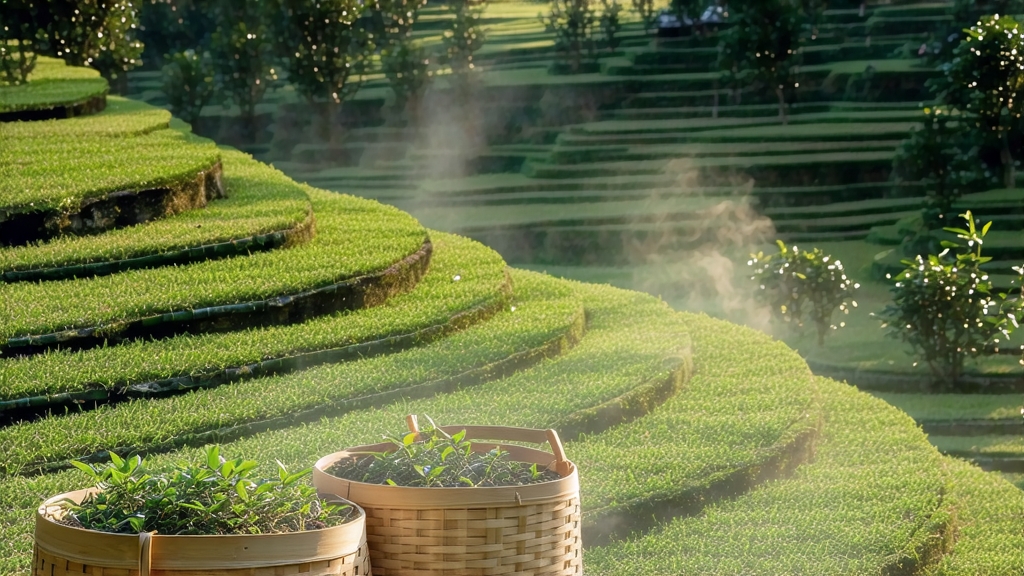
Tucked high on the northern rim of the Sichuan Basin, where the Himalayas throw their first gentle ridges toward the Yangtze, the Meng Ding range has been wrapped in cloud for more than two millennia. It was here, in 53 BCE, that the Daoist recluse Wu Lizhen planted seven tea bushes on the summit of Shangqing Peak, an act that local gazetteers still cite as the birth of cultivated tea in China. When those bushes sent out their first spring shoots, the colour of the downy buds was already a pale, luminous yellow, a hue that later emperors would declare fit only for tribute. By the Tang dynasty the tea was carried in bamboo tubes lined with silk, lashed to post-horses that galloped north to Chang-an; by the Song it was pressed into tiny dragon-phoenix cakes whose golden flecks glittered in the candlelight of the imperial court. What the courtiers tasted was not yet the yellow tea we know today—the secret of “sealed yellowing” would not be perfected until the Ming—but the raw material, the pluck of one bud or one bud-and-initial-leaf, was already identical to the modern Meng Ding Huang Ya.
Meng Ding Huang Ya therefore belongs to the smallest and most aristocratic of China’s six great tea families: yellow tea. Within that family it is classed as “bud yellow tea,” distinguished from the larger-leaf “yellow small variety” of Hunan or the “yellow large variety” of northern Anhui. Because the picking window lasts only from the first week of March to the Grain Rain festival around 20 April, and because only buds standing exactly 1.5–2 cm long are taken, an experienced picker gathers barely 500 g of fresh material in a full dawn shift. Those buds must arrive at the village workshop before ten in the morning, still cool from the mountain mist, or the enzymatic journey that creates the tea’s hallmark yellow colour and mellow “chestnut-apricot” aroma will never ignite.
The crafting of Meng Ding Huang Ya is a choreography of heat, moisture and time that Chinese encyclopaedias call “men huang”—sealed yellowing. First the buds are spread on bamboo trays and allowed to wither for two hours, losing about ten percent of their moisture while the cell walls begin to loosen. They are then pan-fired in woks held at 160 °C for exactly four minutes; the firing is a single, uninterrupted motion of the wrist that presses each bud against the iron, deactivating the grassy enzymes while preserving the golden hairs. Immediately after firing the buds are still bright green; their transformation into pale champagne yellow occurs during the next and most secretive step. While the leaf is still at 50 °C it is wrapped in thick canvas bundles the size of a pillow and placed inside a cedar-lined wooden chest. The chest is slid into a cave-like room where humidity hovers at 85 % and temperature at 28 °C. For the next 48 hours the tea master opens each bundle every six hours to release the accumulated carbon dioxide, then re-wraps it a little tighter. During this slow suffocation the chlorophyll oxidises into pheophytin, carotenoids intensify, and a cascade of amino acids converts into volatile aldehydes that smell of roasted sweet corn and dried apricot. When the master judges the colour to have reached the shade of antique ivory—never darker—the leaf is given a final gentle bake at 70 °C for thirty minutes, then cooled and sorted. The entire process consumes five days and reduces the original 500 g of fresh buds to 100 g of finished tea, a five-to-one ratio that explains why Meng Ding Huang Ya commands prices higher than silver on the Chengdu wholesale market.
To brew the tea Westerners often reach for a glass tumbler, seduced by the ballet of upright buds that stand like tiny golden spears, but a gaiwan or small Yixing pot gives more control. Begin by rinsing the vessel with 85 °C water; cooler water preserves the hairs, hotter water scalds them into a cloudy soup. Use three grams of dry leaf for 120 ml of water, an eyeballed teaspoon that looks almost stingy until the buds swell. The first infusion should last only twenty seconds; it releases a pale straw liquor whose aroma oscillates between fresh lychee and grilled pumpkin. The second infusion, at forty seconds, deepens the colour to old gold and introduces a texture that Chinese